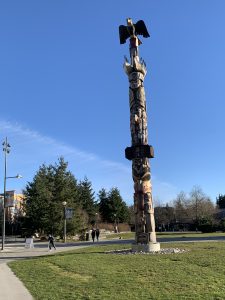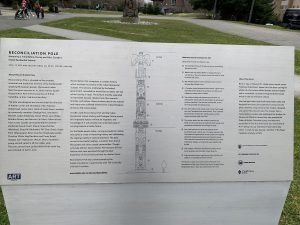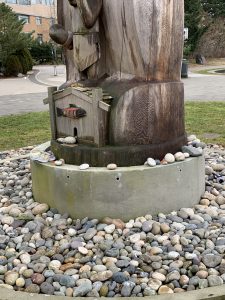
Above: The Reconciliation Pole as pictured on a sunny Friday Morning
Everyday as I walk to my morning coffee, I pass by a grand and intricately designed symbolic piece of art: The Reconciliation Pole of UBC. It stands proudly as a structure that was fabricated through raw, genuine Indigenous imagery at the hands of master carver 7idansuu (Edenshaw), James Hart, with support from the Musqueam Nation of Vancouver. While many students mindfully relax in the green space underneath its shadow, the incredibly significant message regarding its creation is still relatively unknown, excluding its visual appeal as a landmark on campus. Seen in complex detail across the sculpture, a story of the past is illustrated; depicted through images of brutal residential school buildings and uniformed children forced to rely on each other’s support in the absence of a meaningful parental influence. Yet, as one gazes higher up the pole, the family is reunited with their children, displaying themes of strength and belonging. At the pinnacle of this landmark, an eagle overlooks the campus, representing “power, togetherness, determination and speaks to a sustainable direction forward”. Erected in 2017, this pole was constructed in hopes of shedding an accurate and meaningful light on the dark past of the residential schooling system and the perpetual impact of settler colonialism, which continually proliferates ideas of white settler futurity across the societies of Canada. Furthermore, it stands as a beacon for change that strives for a future of cultural acceptance, while engaging in the process of rebuilding a once tarnished relationship with the Musqueam Nation.


Above left: A detailed description about the Reconciliation Pole, including a diagram to inform readers about its creation story and purpose.
Above right: The intricate carvings of wood at the base of the pole
As observed in the CCEL presentation, an overlap between various story forms can be combined to compose an impactful movement for change, “When it comes to changing the values, mindsets, rules and goals of a system, story is foundational” (Saltmarshe, Ella). In the case of the UBC Reconciliation Pole, this landmark exemplifies the struggle for Indigneous land sovereignty and social equality within our nation. This vehement visual piece of art draws empathy from the viewers, informs us about the issue of Indigenous diaspora and elimination across our society, while allowing for cultural narratives to be heard through the intimate relationship that the carver has with his own Indigenous roots. In addition, The Reconciliation Pole points us towards the Indian Residential School History and Dialogue Centre on campus which provides a space for students to appropriately educate themselves about the Truth and Reconciliation Movement. If one truly engages with this meaningful landmark, a new perspective regarding the bleak reality of Indigenous inequality across Canada can be established, appropriately allowing us to situate ourselves within the Indigenous struggle for recognition and justice.
Unfortunately, in my opinion, The Reconciliation Pole is often overlooked and misinterpreted by the public eye for solely being an appealing piece of art. Abominably, this landmark has been vandalized by students in the past; a disrespectful act that indicates the missing maturity that is required when engaging with such a delicate topic. In order for the UBC community to properly immerse themselves within the reconciliation process, I believe that there should be frequent events based on accurately telling the story of this sincere landmark, in relation to the Musqueam Nation’s history in Canada. In addition, the location of the totem pole could be situated in the heart of the campus to garner the attention/recognition it deserves as an integral part of UBC’s history. I believe that this spot should be treated with the utmost respect; not a place to throw a frisbee around, but rather a place to commemorate, reflect upon and learn from. In short, The Reconciliation Pole deserves to be a venerated spot on campus.
Brief video of the sheer size of the pole: IMG_4315
Works Cited
“Open Letter: Reconciliation Pole Vandalized on Eve of Second Anniversary.” Indigenous Portal, 13 Feb. 2020, https://indigenous.ubc.ca/2019/04/01/open-letter-reconciliation-pole-vandalized-on-eve-of-second-anniversary/.
Saltmarshe, Ella. “Using Story to Change Systems.” Stanford Social Innovation Review, 2018. https://doi.org/10.48558/4FVN-0333.
UBC Plaque 2017-Reconciliation Pole-8 – Indigenous Portal. https://aboriginal-2018.sites.olt.ubc.ca/files/2017/10/UBC_Plaque_2017-Reconciliation_Pole-8-1.pdf.
“What Is the Reconciliation Pole?” Student Services, 5 Mar. 2020, https://students.ubc.ca/ubclife/what-reconciliation-pole.
